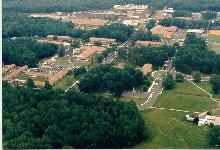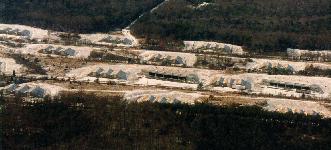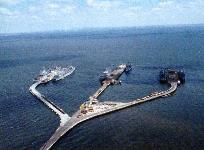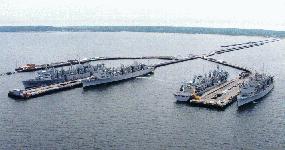






The Public Works Detachment runs the railroad, consisting of 130 miles of track, nine locomotives and 520 pieces of rolling stock. The station also manages handling equipment and containers for the fleet and shore stations, including design, testing, acquisition, in-service engineering and logistical support. Earle is in many ways like a small town, with homes, office buildings, factories, restaurants, cars and trucks.
At the Waterfront, the Ordnance Department provides ammunition for nearly every class of ship operated by the United States Navy and Coast Guard as well as commercial vessels from other countries. The Port Services Division, located on the Pier Complex, provides a full range of services for visiting and homeported ships.Although most of the station's departments and divisions are located in the administrative area Mainside, the majority of military personnel are located at the Waterfront. Combat Logistics Group Two Detachment Earle and the two homeported Fast Combat Support Ships, USS Seattle and Detroit homeported there in 1990 - are located there. In preparing for the arrival of the Seattle and Detroit, a multi-million dollar expansion began. A fourth pier was completed in 1990. It is the permanent home of the Seattle and Detroit.
Many other projects are well underway or already completed. 500 new housing units have been constructed to meet the needs of the Sailors stationed there. At the Waterfront, the Medical and Dental Clinics as well as the Navy Retail Exchange Store have moved to larger quarters and a Ships Intermediate Maintenance Facility has been added. A 20,000 square foot transit shed and a new Bowling Center were also opened.The station's Pier Complex is one of the longest "finger piers" in the world. It is presently comprised of a two mile long trestle which connects to three finger piers - which are Piers 2, 3, and 4. These piers stretch nearly three miles into the Sandy Hook Bay. One mile from the shore the trestle branches off to Pier 1. At the junction of Piers 2, 3, and 4, a concrete platform exits which supports a forklift/battery recharging shop and the port operations building. This area is known as the "wye". All of the existing structures, with the exception of Pier 4 and the "wye", were constructed in the early 1940s. The "wye" was constructed in 1981 and Pier 4 was completed in 1990.
The original pier and trestle were constructed of reinforced concrete slabs approximately two inches to 24 inches thick, and overlaid with an asphalt wearing surface. The docks are supported by more than 41,000 timber piles. Elevated loading platforms line both sides of each pier. Pier and Trestle 4 are constructed of pre-stressed concrete box girders topped by a cast-in-place reinforced concrete deck, supported on precast concrete pile caps and steel pipe piles. A unique feature on Pier 4 is the double deck utility galley/loading platform.
Currently Pier 1 serves as a temporary holding yard for trailers; Pier 2 is vacant; Pier 3 is the ordnance handling pier, and Pier 4 is a homeport pier for the USS Seattle (AOE 3) and the USS Detroit (AOE 4). In support of the larger Seattle and Detroit, the water depth at the pier complex was dredged to 47 feet.
Since World War II the pier complex has provided ammunition services to almost every class of vessel operated by the Navy and Coast Guard as well as commercially owned vessels from a multitude of nations.
Over the years, the station has taken on many important functions. It has become the engineering agent for the Naval Sea Systems and Naval Air Systems Command in the field of packaging, handling, stowage and transportability of weapons systems. A new facility mainside houses the departments involved in weapons handling and container design, test and acquisition. The Naval Packaging, Handling, Storage, and Transportation (PHST) Center is responsible for the design, development, prototype fabrication, testing, production acquisition, and documentation of ordnance containers and handling equipment for the US Navy. The Center is recognized as the largest organization for such work in the United States, and has the facilities, equipment, and professional staff necessary to accomplish the required work.


